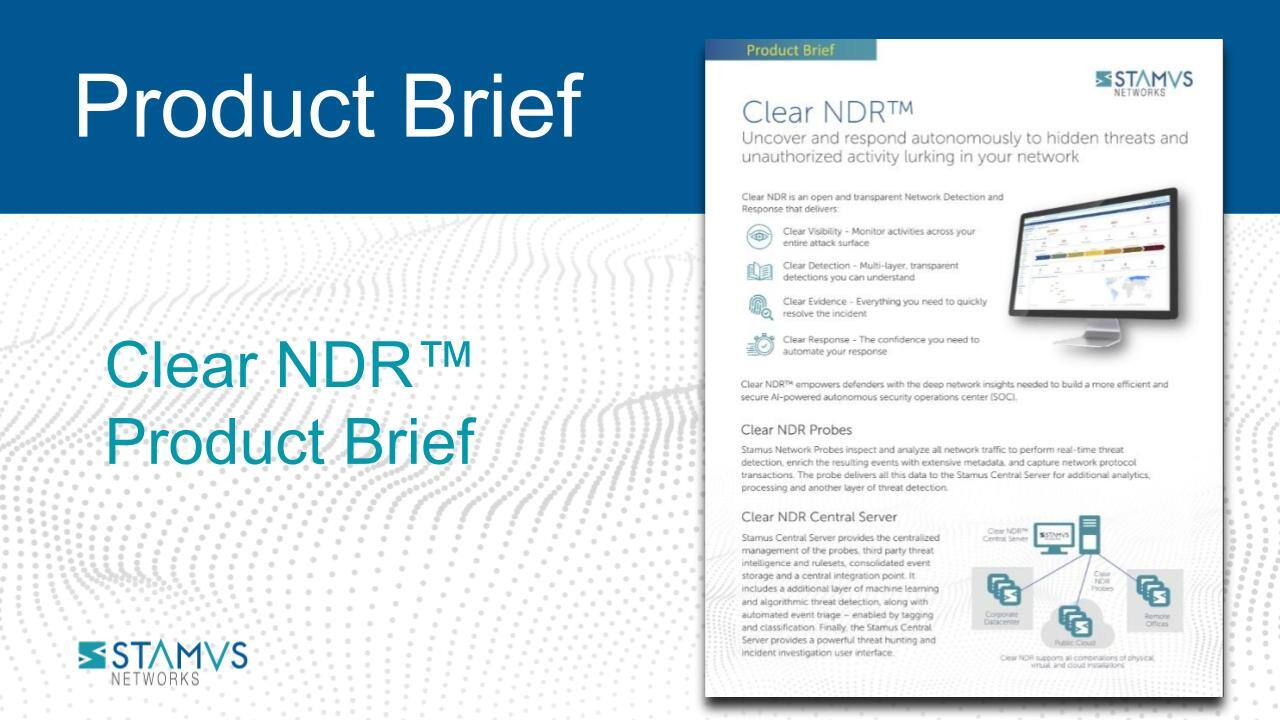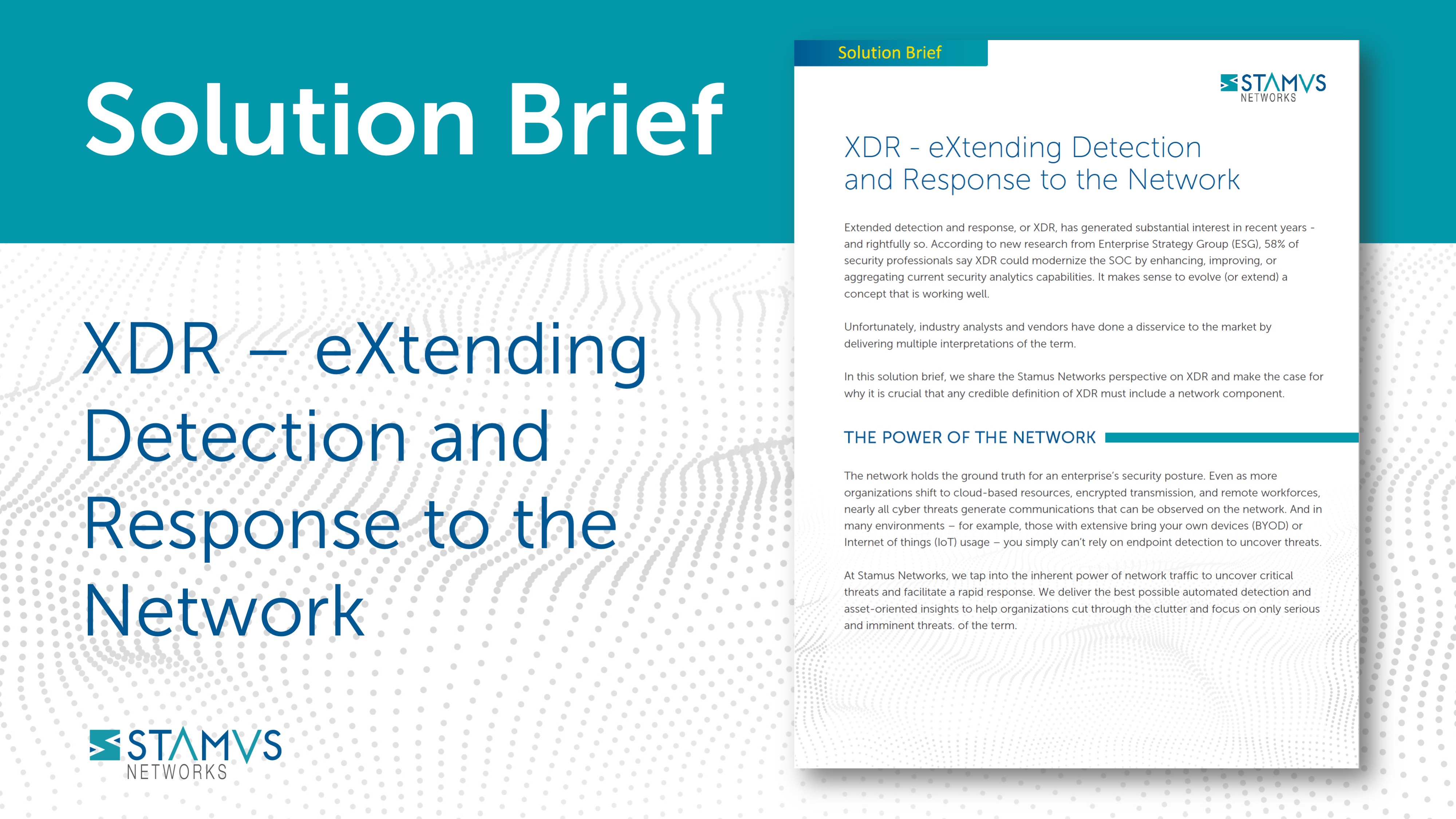Network Detection and Response
Conventional security measures are falling behind. Unfortunately, the threat landscape has evolved, and threat actors are employing new techniques that require more advanced cybersecurity solutions capable of keeping up. Research by CFO has found that 55% of cybersecurity experts have reported increased level of stress doing to growing cybersecurity risks and challenges. Thankfully, network detection and response (NDR) has emerged as a highly capable adversary to modern security threats.
This introductory guide serves as your gateway to understanding NDR - we’ll explore:
- Fundamental principles
- Tools it uses to detect advanced novel threats, and
- Alternative systems that can help an organization create a more comprehensive cybersecurity strategy.
Regardless of your experience in network security practices, this guide seeks to provide an introduction into the world of network detection and response.
What is Network Detection and Response?
Network detection and response is a cybersecurity approach that monitors and analyzes an organization’s network traffic to identify and respond to potential threats. NDR solutions go beyond traditional or legacy network security measures by monitoring traffic in near real-time. They leverage advanced detection mechanisms such as artificial intelligence and machine learning to detect and respond to potential security incidents. The primary goal of NDR is to enhance the organization’s ability to both detect and respond to threats, reducing the risk of data breaches or unauthorized access.
Network detection and response systems continuously collect and analyze network traffic data, using a combination of signatures or rules and advanced algorithms to identify known threats, abnormal patterns, or signs of malware infection. Anomalous activities that NDR systems can identify include:
- Unusual data transfers
- Suspicious user behaviors
- Possible malware beaconing activity
- Data exfiltration, and more.
Many NDR systems include tools for behavioral analysis, which allow the system to establish a baseline of “normal” network behaviors, enabling them to recognize deviations indicative of potential security threats.
One thing that sets NDR apart from many traditional security tools is its combination of capabilities. While most NDR systems do include detection methods based on predefined rules or signatures (such as those found in an intrusion detection system), they also include more modern detection methods that allow the system to dynamically adapt and respond to emerging threats. By pairing both classic and modern detection methods with other features, such as threat hunting interfaces, NDR enables an organization to practice a much more proactive and well-rounded security strategy.
NDR plays a crucial role in an organization’s overall cybersecurity strategy, providing deep visibility and insights into network activities, in turn helping security professionals respond swiftly to potential incidents. As cyber threats continue to evolve and adapt, NDR is becoming an increasingly vital and necessary component to creating a fully comprehensive cybersecurity strategy.
What does Network Detection and Response do?
Network detection and response (NDR) solutions actively and continuously scan network traffic and then use a variety of detection methods to identify and respond to potential threats in real-time, offering a dynamic defense mechanism against cyberattacks. Then, the NDR will often categorize and prioritize incidents, enabling security teams to address the most critical issues promptly. Additionally, network detection and response solutions generally include the ability to automate response actions or send notifications to the organization’s security team.
What is Detection and Response in Cyber Security?
The idea of “detection and response” encompasses a range of solutions, which includes systems focused on the network, the endpoints, or a combination of both. A strategy centered around detection and response typically recognizes that preventing all potential cyber threats is realistically impossible, so it emphasizes the timely detection of potentially or known malicious activity paired with a swift, effective response that can minimize damage. Regardless of the approach, the goal of a threat detection and response system is to proactively identify and mitigate cybersecurity threats.
Network detection and response (NDR) seeks to achieve this goal by monitoring the communication and traffic happening on an organization’s network. The best NDR solutions monitor in real-time and also provide the most detailed, comprehensive view of an organization’s digital infrastructure.
There are a number of resources available to help determine the best NDR solution for your organization. While that decision will ultimately come down to the unique needs and desires of each individual organization, a good starting point is to look at insights from industry consultants.
What is an NDR Provider?
A network detection and response (NDR) provider is a cybersecurity vendor that offers solutions and expertise in deploying, managing, or optimizing NDR capabilities for organizations. NDR vendors play a pivotal role in enhancing the cybersecurity posture of businesses by delivering specialized tools and services that focus on real-time monitoring, analysis, and response to potential threats within computer networks.
Some network detection and response vendors often offer a range of services outside of their product, including the implementation and configuration of NDR tools, ongoing monitoring of network traffic, incident response, and threat intelligence integration. They may also provide expertise in analyzing and interpreting the data generated by their NDR solution, aiding organizations in making informed decisions to strengthen their security posture.
Choosing the right NDR vendor is crucial for an organization seeking to improve their cybersecurity defenses. Factors to consider when selecting a network detection and response vendor include:
- Scalability of their solutions
- Depth of their threat intelligence
- Comprehensiveness of their monitoring capabilities, and
- Effectiveness of their incident response protocols.
A strong partnership with an NDR vendor can contribute significantly to an organization's ability to adapt to emerging cyber threats and maintain a resilient cybersecurity infrastructure.
To learn more about which characteristics your organization should consider when evaluating an NDR system, please read “Six Essential Requirements for Network Detection and Response (NDR)”.
What are NDR Tools?
NDR systems are made up of a variety of tools which determine the detection method used to identify potential threats. These network detection and response tools play a crucial role in how network traffic is examined and the outcome of that examination. Not every NDR will be comprised of the following tools / capabilities, however many of these are common:
- Deep Packet Inspection: Some NDR systems perform real time capture and analysis of network traffic to extract metadata, understand communication patterns, detect potential threats, identify anomalies, and log activity.
- Behavioral Analysis Engines: NDRs use machine learning and behavioral analysis to establish baselines of normal network behavior and detect deviations that may indicate malicious activities.
- Threat Intelligence Integration: Competent NDR solutions integrate with third-party threat intelligence feeds to enhance detection capabilities with up-to-date information about known threats and indicators of compromise.
- Network Forensics: Network forensics tools assist in investigating security incidents by analyzing historical network data, helping security teams understand the scope and impact of a potential breach.
- Automated Incident Response: Most NDR systems can trigger predefined automated responses to security incidents, allowing for quick containment and mitigation of threats.
- Vulnerability Discovery: Some NDRs claim to identify and assess vulnerabilities within the network that could be exploited by attackers, contributing to proactive threat mitigation.
- Threat Hunting: A threat hunting platform uses data collected by the NDR to filter through network traffic and identify user-selected threats, suspicious behaviors, or anomalous activities.
What Challenges does Network Detection and Response Solve?
Network detection and response (NDR) addresses several critical challenges in cybersecurity, enhancing an organization's ability to safeguard its networks, assets, and data. These challenges make up a number of network detection and response use cases that an organization must consider when evaluating their security needs.
- Advanced Threat Detection: Traditional security measures often struggle to detect advanced and evolving threats. NDR employs advanced analytics, machine learning, and behavioral analysis to identify anomalous patterns and behaviors. This allows for the early detection of sophisticated threats like zero-day exploits and advanced persistent threats (APTs).
- Visibility and Context: NDR provides comprehensive visibility into network activities, helping organizations understand what is happening within their networks. This visibility includes insights into user behavior, device interactions, and application usage, offering context that is crucial for effective threat detection and response.
- Real-time Network Monitoring: NDR tools operate in real-time, enabling organizations to monitor network activities continuously. This real-time capability reduces the "dwell time" of threats—the duration a threat goes undetected within the network—minimizing the potential impact of security incidents.
- Insider Threats: NDR is effective in identifying unusual user behaviors that may indicate insider threats or compromised accounts. By monitoring user activities and setting baselines for normal behavior, NDR tools can detect deviations that may signify malicious intent or unauthorized access.
- Improving Incident Response Time: NDR facilitates rapid incident response by automating certain actions and providing timely alerts to cybersecurity teams. This quick response time is crucial for preventing the escalation of security incidents and minimizing the damage caused by a breach.
- Adaptability to Evolving Threats: The cybersecurity landscape is dynamic, with new threats emerging regularly. NDR's adaptive nature, leveraging mechanisms such as machine learning and updated threat intelligence, allows organizations to stay ahead of evolving threats by dynamically adjusting to new attack vectors and tactics.
- Reducing False Positives: NDR tools employ sophisticated analytics to reduce false positives, ensuring that security teams focus on genuine threats rather than spending time investigating benign events. This enhances the efficiency of cybersecurity operations.
What is the Difference Between Network Detection and Response and IDS/IPS?
The difference between network detection and response and DIS/IPS is that NDR has the ability to detect far more advanced threats with greater certainty than traditional signature-based IDS/IPS methods.
NDR continuously monitors and analyzes network traffic, utilizing advanced technologies such as machine learning, behavioral analysis, and real-time monitoring. NDR solutions aim to identify anomalies or patterns indicative of malicious activities, providing organizations with visibility into their network and enabling them to respond swiftly to potential threats.
Unlike NDR’s approach, IDS/IPS is reactive, relying on a limited database of known threats and vulnerabilities to stop malicious traffic from entering or leaving the network. IDS/IPS is geared towards preventing and blocking traffic associated with known threats at the network perimeter. IDS/IPS operates by enforcing predefined rules and signatures to identify and block malicious traffic. It acts as a barrier at the network perimeter, inspecting incoming and outgoing traffic for known attack patterns and vulnerabilities.
In essence, the key difference lies in their primary functions:
NDR focuses on responding to both known and unknown threats, while IDS/IPS concentrates on blocking only known threats based on predefined rules. Some NDR systems will include IDS/IPS functionality in addition to more advanced detection mechanisms, whereas legacy IDS/IPS solutions will rarely, if ever include modern features like AI or machine learning.
What is the Difference Between NDR and EDR?
In general, NDR allows greater visibility into network traffic, while EDR is focused on monitoring individual devices.
Network detection and response (NDR) and endpoint detection and response (EDR) are complementary components of modern cybersecurity strategies, with each focusing on different aspects of threat detection. When comparing NDR vs EDR, it isn’t necessarily a competition about which is better. Ideally, a mature organization would be able to deploy both. However, if forced to choose between one or the other, the choice will have to result from the needs, budget, and unique structure of the organization.
EDR tools are designed to monitor and respond to threats at the endpoint level. This means that an EDR will monitor individual devices such as computers, servers, or mobile devices. This is done using an endpoint agent (a background application installed on the device's operating system). An EDR solution will monitor the endpoint agent and use it to address suspicious activities, malware, or malicious processes that have infiltrated the endpoint. Once a threat is identified, the EDR might then quarantine the endpoint to prevent the threat from spreading until an analyst can respond.
A network detection and response solution, as discussed previously, will monitor threats at the network level. It is important to clarify that network monitoring is done passively without the need to install an agent on every device. This is especially useful for organizations that support a bring-your-own-device work environment. In many cases, an organization not only has physical devices that belong to them, but their network is also accessed by unsecured or otherwise unmonitored devices. In these scenarios, an NDR is ideal because it allows greater visibility into the network traffic as opposed to an EDR tracking individual device activity.
Combining both of these tools is essential to creating a comprehensive cybersecurity strategy, as they complement each other to provide a holistic view of the organization's infrastructure.
What is the Difference between EDR and XDR?
The main difference between EDR (endpoint detection and response) and XDR (extended detection and response) is that XDR seeks to achieve a more holistic approach, focusing on additional sources of telemetry outside of the endpoint. There are three main approaches to XDR:
- Open XDR: An evolution of SOAR and SIEM systems, where the tool accepts various sources of telemetry and seamlessly integrates with different components like EDR, NDR, and server logs. The goal with an Open XDR system is to improve the SOAR and SIEM combo by providing greater flexibility, interoperability, and functionality.
- TDR Extended: In this approach, a vendor seeks to extend the offering of their existing EDR or NDR by integrating additional telemetry sources to create a broader analytics, hunting, and response.
- Single Vendor XDR: This approach is seen at very mature cybersecurity vendors, where the vendor repackages their existing individual point solutions into a single, comprehensive XDR system. Single XDR is great in theory, but in practice there are numerous drawbacks such as vendor lock-in and the potential for the entire system to only be as effective as its “weakest link”.
All of these differ from EDR solutions, which only gather data from individual devices, such as laptops, desktops, servers, or mobile devices. So how can an organization choose between NDR vs EDR vs XDR? Truthfully, there isn’t a definitive answer. Each organization must consider their needs, budget, strategy, and existing software stack. There is not a “one size fits all” solution. Ideally, every organization could deploy a combination of all three systems, however the reality is much more complex than that.
What is Open NDR?
When considering threat detection and response solutions, Open NDR could be a solution that ensures an organization does not set themselves up for future frustration. Generally, the term “open” in the context of cybersecurity often implies a system or approach that is interoperable, extensible, and compatible with various technologies. It might suggest an emphasis on openness, collaboration, and integration with other security solutions.
This means that Open NDR, by definition, is a network detection and response system that can seamlessly integrate with other systems such as SOAR, SIEM, Firewall, EDR, or XDR. It is important to look for this trait in any cybersecurity solution to make future product inclusions, updates, or changes integrate more effectively.
We recommend choosing an open and extensible NDR system like the Clear NDR - Enterprise (formerly Stamus Security Platform). By choosing an Open NDR, you give your organization greater flexibility in tailoring a cybersecurity strategy to the unique needs of your organization.
Stamus Networks: Your NDR Partner
As organizations strive to stay ahead of evolving threats, the need for real-time monitoring, advanced analytics, and proactive threat detection becomes increasingly evident. NDR not only addresses the challenges posed by advanced threats but also contributes to reducing incident response times, enhancing visibility, and adapting to a constantly changing threat landscape.
There are a lot of NDR vendors to choose from, and that choice can make a large impact on your organization’s cybersecurity posture. Stamus Networks is a global provider of high-performance network-based threat detection and response (NDR) systems. Our solution, Clear NDR (Formerly Stamus Security Platform), helps enterprise security teams know more, respond sooner, and mitigate threats.
To see if network detection and response is a fit for your organization, click on the request a demo button below to schedule time with one of our engineers.











.png)


